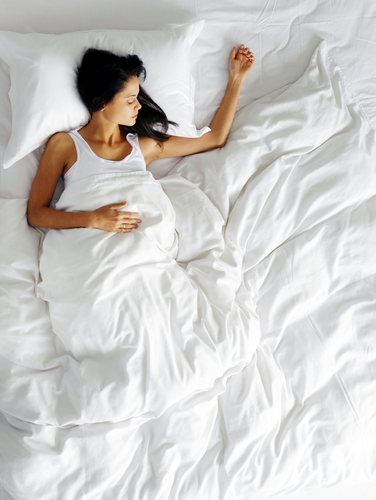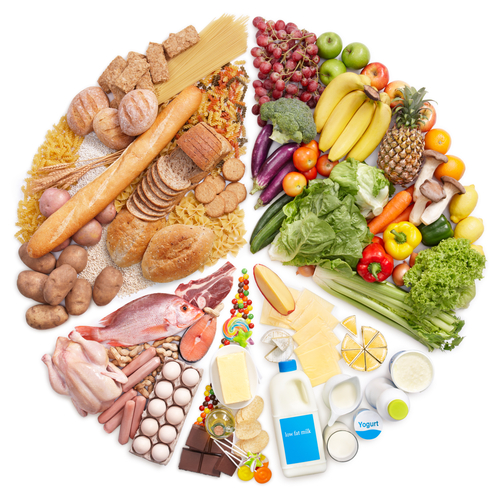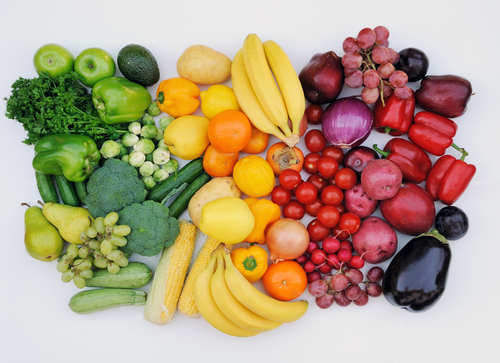Foods to Help You Get More Shut Eye
In today’s fast-paced world it is very common to miss out on getting enough restful sleep each night. The challenge of balancing proper rest with everything else that needs to get done in a day can be very tricky. However, many are not aware that not getting enough rest can wreak havoc on your eyesight. While it’s obvious that lack of sleep can cause dark circles to appear under your eyes, not getting enough rest can interfere with your eye health.

Getting quality shut eye can be especially difficult if your body is still awake, but there are some foods that can actually help to induce sleep and achieve a more restful night. Here are a few sleep-promoting bedtime snacks to consumer an hour before hitting the hay:
Peanut butter and crackers Some all-natural peanut butter spread on some whole wheat crackers provides a mix of carbohydrates and protein with a bit of tryptophan.
Cheese stick Snacking on a low-fat cheese stick before bedtime also supplies tryptophan as well as lean protein, which can leave you calm and less frazzled while helping to keep your blood sugar on an even keel throughout the night.
Bananas and nuts Eating half a banana along with a handful of your favorite nuts provides your body with tryptophan and carbohydrates.
A bowl of cereal The milk contains tryptophan and the whole-grain cereal adds some complementary complex carbohydrates. Avoid the sugary cereals as sugar can cause sleep-disrupting blood sugar crashes during the night.
Make sure you eat dinner at least three hours before bedtime and have one of these snooze-inducing snacks about an hour before you climb into bed. You never want to go to bed full or hungry – both can be disruptive to your rest. Instead try to find a happy balance and you may just get a more sleep-filled slumber.
As the weather warms up, visions of sandy beaches, family picnics, and outdoor adventures become reality, but with all that time outside, don’t forget to keep your peepers protected from the serious dangers associated with UV rays. Just as we make the effort to protect our skin from sunburns, we should also make sure that our eyes are safeguarded as well so that we can maintain healthy vision for many summers to come.

Here are some ways to protect your eyes from sun damage this summer.
- Know about ultraviolet radiation. There are three different ranges of ultraviolet radiation (UVA): UV-C, UV-B and UV-A. Most eye damage is a result of UV-B rays, which many researchers suspect may contribute to the development of cataracts and eye cancer.
- Keep kids’ eyes protected. It’s estimated that we receive 80% of our lifetime exposure to ultraviolet rays before the age of 18. Children’s eyes transmit more UV-A rays to the retina than adults’, which increases their exposure and risk of eye damage later in life.
- Sport your sunglasses. Wear sunglasses that transmit no more than 1% of UV-B and UV-A. The lenses should be dark and large enough to cover your entire eye to prevent sunlight from getting in through the sides of the sunglasses.
- Add more protection with contact lenses. If you’re one of the approximately 36 million Americans who wear contact lenses, you might already be protecting your eyes. Some contacts provide ultraviolet ray protection, but beware that protection levels vary. Class one UV-blockers provide the largest amount of protection.
- Wear a hat. Wide brimmed hats shade your eyes from the sun’s rays.
Age-related macular degeneration is the leading cause of vision loss for those aged 55 and older in the United States, affecting more than 10 million Americans. Age-related macular degeneration is caused by the deterioration of the central portion of the retina, the inside back layer of the eye that records images and send them via the optic nerve from the eye to brain. The retina’s central portion, known as the macular is in charge of focusing central vision in the eye. It controls our ability to read, recognize faces and colors, drive a car, and see objects in fine detail.
As people get older, chances for developing the eye disease increases. Since AMD has few symptoms in its early stages, it is important to have your eyes examined regularly.
Although there is no cure for age-related macular degeneration there are treatments available to maintain vision loss. There is also clear evidence that certain dietary choices can help slow vision loss. Here’s a list of foods to consider packing for lunch or making for dinner to help in the fight against age-related macular degeneration.

Fruits & Vegetables
Antioxidants are protective for AMD; therefore you should 5 – 9 servings of fruits and vegetables a day. While this may sound like a lot, a serving is really only half a cup of most foods or one cup of leafy greens.
Vegetables:
Fresh veggies – Baby carrots, cherry tomatoes, snap peas, and precut vegetables are quick and easy to snack on.
Add vegetables to sandwiches, wraps and salads – Chop up portions of broccoli, bell peppers and celery, and don’t forget to pile on the fresh mixed greens and spinach.
Frozen veggies – Try frozen vegetables you can steam in the package. These are great if you’ve got a microwave available in your office kitchen and are looking for a quick, healthy lunch.
Fruit:
Whole fruits – Bananas, apples, oranges, clementines, pears, grapes, nectarines and peaches are easy to grab and go for a healthy snack.
Canned fruit – Try individual serving cups or cans of mandarin oranges, peaches or fruit cocktails that are canned in juice, not syrup.
Whole Grains
Incorporate whole grains into your meals. Consider making that sandwich or lunch wrap on 100% whole wheat bread or a whole wheat wrap or pita. If you’re trying to cut back on carbohydrates in your diet, consider a low-carb version instead. You can also try quinoa or quick-cooking barley.
Proteins
Try incorporating some of these foods filled with protein into your daily lunch:
Canned tuna
Reduced-sodium canned beans
Hard boiled eggs
Unsalted nuts
Reduced-sodium lean deli meat such as turkey, chicken or roast beef
Dairy
Some dairy products to add to your daily diet:
Skin or 1% milk. Choose soymilk or almond milk if you are lactose intolerant.
Light yogurt or non-fat Greek yogurt. Choose plain varieties as those that are flavored usually have more carbohydrates.
Cottage cheese
Fish
Individuals who eat fish two to three time a week have a lower risk for AMD. Fish contains omega-3, which is a critical nutrient for a healthy heart and eyes.
Some Extras for Flavor
Hummus
Hot sauce
Light salad dressing
Mustard
Salsa
Balsamic vinegar
Olive oil
Lime and lemon juice
It does take some planning, but bringing a homemade lunch and additional healthy snacks to work is an easy step toward a healthier lifestyle and better vision.

Are you one of the approximately 36 million Americans who wear contact lenses? Chances are that you went through a mini-course in proper hygiene with your eye doctor when you first obtained your prescription, but if you’re being completely honest, any typical morning might involve waking up, getting dressed, brushing your teeth, throwing in your contact lenses and quickly drinking some coffee before heading out the door to greet the day. That all-too-quick minute used to put in your contact lenses may seem as insignificant and routine as choosing a travel mug for your morning coffee, but think about it, those lenses you are hastily placing in your eyes are custom-fitted, doctor-prescribed medical devices that should be given a whole lot more consideration.
Avoid these common mistakes when it comes to wearing contact lenses and enjoy crisp, clear and healthy vision.
Never use water or your own saliva as “emergency” contact lens solution
If you’re out and about and find that your contact lenses are bothering you, but you don’t have any contact lens solution readily available, you should never use water or your own saliva as a substitute. Saliva is ridden with bacteria that belongs in your mouth and not in your eye. Water also contains bacteria that should not make contact with your eyes. If you find yourself in a situation where your contact lenses are bothering you, use lubricating drops made especially for contact lens wearers, not drops that are used to combat red eye, to try and relieve your discomfort.
Do not allow tap water to come in contact with your lenses
Tap water does not have the same salty properties as tears and if it comes in contact with your lenses they will absorb the water and swell. IF you contact lens swells, it changes how the lens fits your eye and will make the lens tighten on your eye. This can create microscopic breaks in your cornea that microorganisms can get in to, potentially causing an infection. That’s why it is important to never shower or swim with your contact lenses in.
Put your contact lenses in before applying makeup
To avoid getting makeup on your contact lenses, put them in before applying your makeup and conversely, be sure to take them out when you are removing makeup.
Avoid waterproof makeup
If waterproof makeup gets on your contact lens it will bind to it. Since waterproof makeup requires an oil-based remover, it will grease up the eyes and the lenses.
Swap out your old contact lens cases every three months
If you’ve been using the same contact lens case for as long as you can remember, that that old case out immediately. Contact lens cases should not be used for more than three months. If you’re been storing your lenses in the same case for more than three months, you should swap the container out for a new one immediately.
Do not wear your daily or monthly contact lenses longer than recommended
If you’re wearing your daily lenses for more than a day or your monthly lenses for more than a month you should stop. Your contact lenses are made of plastic, but they actually have pores to help keep them moist while in your eyes. These pores can get dirty and trap debris and dirt in the lenses, and if you use your contacts for longer than recommended, you run a serious risk of eye irritation, dry eye or infection.
Never sleep with your contact lenses in
Sleeping with your contact lenses in severely limits oxygen transmission. When you’re awake, your cornea receives oxygen from the air and from your natural tears, but when you are asleep, the cornea receives less nourishment, lubrication and oxygen because your eyes are closed and are not blinking. Therefore when you leave your contact lenses in overnight, you’re further depriving your cornea of oxygen. This can lead to your lens tightening in your eye causing microscopic rips to the cornea, and if for some reason there is a microorganism in your eye, it can then enter through that rip in the cornea and lead to an infection. Some contact lenses have been approved by the FDA for overnight and extended wear, but you should always consult with your doctor in order to obtain such prescription lenses.

March is Workplace Eye Wellness Month. Whether you spend hours in front of a computer or use power tools at your day job, it is always important to keep eye health and safety in mind as the gift of sight is irreplaceable.
With more and more individuals depending on technology to accomplish tasks throughout the day, the risk of eye strain and its effects on vision become greater. This increased use of digital devices exposes workers to eye strain as they tend to spend long, uninterrupted amounts of time focusing on computer screens.
All of this screen time can result in computer vision syndrome. Computer vision syndrome is a group of eye and vision-related problems that result from prolonged computer use. Symptoms can range from eye twitching to physical fatigue.
There are some things that you can do to prevent computer vision syndrome if you do spend a large portion of your day in front of a computer screen.
Utilize the 20/20/20 Rule
Take a 20 second break every 20 minutes and focus your vision on something that is 20 feet away.
Remember to blink
When working on a computer or any other electronic device for an extended amount of time, you tend to blink less often. It’s important that you do remember to blink, however, because blinking keeps your eyes moist, preventing dry eye from occurring.
Regular eye exams
The first step in preventing computer vision syndrome is to schedule a regular eye examination with your doctor. Eye exams are a great way to keep tabs on your eye health. Be sure to tell you eye doctor if you use electronic devices as part of your daily work routine.
Computer eyewear
Your eye doctor may be able to prescribe eyewear specifically designed for computer use. This eyewear can actually help alleviate eye strain when using electronic devices.
T
ake mini breaks
If you can, take short, frequent breaks from working on your computer. Get up, stretch, walk around, and give your eyes a rest from focusing on your screen.
If your job requires the use of heavy machinery, be sure to remember safety glasses. All it takes is a tiny sliver of metal, a particle of dust or a splash of chemical to cause significant and even permanent eye damage.
Our eyes are extremely delicate organs, and while most of us often think more about staying warm in the winter months rather than taking care of our eyes, injuries and irritation can just as easily occur in February as in June. Whether you’re hitting the slopes, heading to work or just getting cozy by the fire, you should be aware of your surroundings when it comes to protecting your vision. Here are some easy tips to keep your eyes healthy this winter.

Don’t forget your sunglasses.
Snowy conditions can actually double the sun’s effect as ultraviolet rays enter your eyes from above and are also reflected off the snow into your eyes. Wearing sunglasses that block 99 to 100 percent of ultraviolet light as well as wearing a hat or visor during particularly bright conditions can help to protect your eyes.
Keep your eyes moist.
Heat and indoor air circulation can cause irritation and eye dryness. It can be especially painful and annoying for those who already suffer from dry eye, a chronic condition in which the body doesn’t properly produce tears. To combat the effects of heat and air circulation try sitting farther away from sources of heat and using artificial tears or a humidifier to alleviate dryness.
Wear proper eye gear.
It’s very easy for dirt, slush and even ice to get into your eyes while you’re participating in outdoor activities during the winter season. Sunglasses can help, but they don’t always do enough; wear goggles for maximum eye protection. Find a pair that has enough room for you to wear sunglasses underneath them or find a pair that already has built in UV protection.
We all know that proper nutrition is crucial in maintaining long-term wellness, and as more and more Americans tackle issue associated with obesity, such as heart disease, diabetes, and even premature death, it is becoming more evident that poor nutrition has a negative effect on health. Proper nutrition isn’t just essential for your overall health, it’s also important for the health of your eyes.

Omega-3 Fatty Acids
Omega-3 fatty acids, which can be found in fish such as salmon as well as sardines, are key to preventing eye problems such as macular degeneration and cataracts. They’re also known to boost the health of your brain and heart.
Vegetables
Vegetables also play a vital role in protecting your eyes and contributing to good nutrition. The nutrients zeaxanthin and lutein can be found in spinach, broccoli, and Brussels sprouts. Just like omega-3 rich foods, these veggies don’t just safeguard against eye problems, but they help protect your body from cancer. They’re loaded with nutritional value that can also serve to boost your immune system.
Smoking
When you eat unhealthy foods, the implications of such decisions become obvious. The fact is that when the body doesn’t get proper nutrition, maintaining both proper eye health and good overall health becomes much more difficult. There are other steps that should be taken in order to protect your eyes, for example, if you smoke you are at a far greater risk of developing eye problems than people who do not. The eye can actually absorb toxic substances directly from cigarette smoke. Most alarmingly, studies have shown that people who are four times more likely to go blind as they reach old age than those who do not smoke. In addition, if you’re looking to get the most nutritional value from your food, smoking actually works against you. Studies have shown that a smoker’s body cannot absorb the same level of nutrients, such as vitamin C, vitamin D and calcium, as a non-smoker. One of the fasted ways to improve your overall eye health is to stop smoking.
Smartphones and Your Eyes
We probably all heard this one as a kid: “Don’t sit too close to the TV or you’ll strain your eyes!” Now fast forward to the age of smartphones, and everyone is constantly looking at a screen that’s only a few inches away from their eyes.
Recent studies estimate that half of American adults use a smartphone or table to get their news. That staggering number makes you wonder what sort of impact all of that screen time has on our eyes. If you finish your day wondering why your eyes feel tired, then you may want to consider exactly how you’re using them. It’s more than likely you’ll discover you’re spending a lot of your time looking at once device screen or another.
Being able to easily access information anywhere means that we’re constantly bombarded by computer screens. This can be great for work, fun, and general functionality, but it can be very difficult for our eyes to deal with on a day-in, day-out basis.
Whether you wear glasses or contacts, you need to make sure you give your eyes a break, because it is more than likely that your smartphone and other mobile devices are causing eye strain. If you’re like most Americans, chances are you’re probably quite attached to your smartphone, but don’t forget about your eye health. Studies have shown that people hold their mobile devices too close to their face, which forces their eyes to work extra hard. So give your eyes a break whenever you can.

Set Your Smartphone Aside Whenever Possible
Sure you need your smartphone, but you also need healthy eyes and vision. Besides chronic eye strain and fatigue, you can actually serve to decrease your productivity and quality of life by not properly resting your eyes. Taking breaks from your smartphone is the first step in giving your eyes necessary rest. It may not be easy, but you do need to remember to ditch that smartphone from time to time and let your eyes rest.
In fact, it might not be a bad idea to put your smartphone away for one day per week. Of course this doesn’t mean that you should spend the day without your tablet, PC or laptop altogether, but if possible, you should give your eyes at least one full day a week where they are free from the flare of computer screens – no matter how large or small. The end result will be rested eyes that will suffer from less fatigue.
This month is National Glaucoma Awareness Month. January is an important time to raise awareness and spread the word about glaucoma, its symptoms and its treatment. The disease is considered the “silent thief of sight” as there are virtually no symptoms associated with it and once vision is lost, it’s gone for good. As much as 40% of vision can be lost before any sort of change is noticed. Glaucoma is the leading cause of preventable blindness. Currently there is no cure for glaucoma, but with early detection and treatment, its effects can be slowed down and further vision loss can be prevented. Over 2.7 million Americans, and over 60 million people worldwide, have glaucoma. Experts estimate that half of these individuals don’t even know that they have the disease. With these numbers growing, it is very important to not only receive regular eye examinations, but to help raise awareness about the disease as well.
Help Raise Awareness about Glaucoma
 Talk to your friends and family about glaucoma and the importance of regular comprehensive eye exams. If you have glaucoma, let your family members know as it’s important for their eye doctors to know about the family history associated with the disease.
Talk to your friends and family about glaucoma and the importance of regular comprehensive eye exams. If you have glaucoma, let your family members know as it’s important for their eye doctors to know about the family history associated with the disease.
What is Glaucoma?
Glaucoma is a group of eye diseases that gradually steal sight without any warning. Although the most common types of glaucoma primarily affect people who are middle-aged and the elderly, it can affect people of all ages. Vision loss is caused by damage to the optic nerve. The optic nerve acts like an electrical cable with over a million wires and is responsible for carrying images from the eye to the brain. There’s no cure yet for glaucoma, but with medication or surgery, further vision loss can be prevented.
Types of Glaucoma
There are two main types of glaucoma – primary open-angle glaucoma and angle-closure glaucoma. These are marked by an increase in intraocular pressure, or the pressure inside of the eye. When optic nerve damage occurs despite normal eye pressure, this is known as normal tension glaucoma. Secondary glaucoma refers to any case in which another disease contributes or causes increased pressure, which then results in optic nerve damage and consequently vision loss.
Facts about Glaucoma
According to the World Health Organization, glaucoma is the second leading cause of blindness in the world. The most common form of glaucoma has virtually no symptoms. Vision loss begins with peripheral vision, so if you have glaucoma you may not really notice anything until a significant amount of your vision has been lost. One of the best ways to protect your sight from glaucoma is to get a comprehensive eye examination on a regular basis. Glaucoma is the leading cause of blindness among African-Americans as well as Hispanics. Also, siblings of people diagnosed with the disease have a significantly increased risk of developing glaucoma as well.
Most of us associate sunglasses with warm weather, hanging out at the beach, and other fun summertime activities, and while sunglasses are important for preventing UV damage to our eyes, most of us make the mistake of forgetting to wear our favorite shades during the cold, and sometimes snowy, winter months. Here are some important reasons why it is important to always remember to wear your sunglasses – any time of the year.

Sunglasses aren’t just fashionable. Sunglasses have been a fashion staple since the 1930s, and of course the right pair of shades can add a certain amount of “cool” to any outfit, but a quality pair of sunglasses are also important to your visual health as they help to block harmful UV rays from reaching your eyes.
Sunglasses can help prevent the symptoms associated with dry eyes during winter weather. If you’ve ever experienced dry eye syndrome, you know how uncomfortable constantly dry eyes can be. While some people suffer from chronic dry eye, others associate it with seasonality, and winter is typically the worst time of the year for red, irritated and dry eyes. Wearing sunglasses is an especially good move for anyone who spends a considerable amount of time outside during the winter months. Wearing sunglasses will not only help to prevent the symptoms of dry eye, but also help prevent damaging UV light from entering the eyes. If you experience chronic dry eye you might want to consider purchasing wrap-around style sunglasses to block wind and dust from reaching the eyes as well.
UV rays are just as harmful during the winter as they are during the summer. Damage from the sun can occur just as easily in the winter as it can during the summer months. Many snowboarders and skiers experience “goggle tan” that comes from UV light giving them a tan, or possibly even a sunburn, on the exposed area of skin surrounding their ski goggles. That same light can cause damage to the eyes, which can also lead to macular degeneration and the progression of age related eye disease. Yet another reason why wearing your sunglasses during the winter months is important.
Sunlight reflected off snow can actually cause greater glare than any light during the summer months. While summer sun light is a little brighter than the winter sun on a clear day, light reflecting off snow can make glare levels extremely high and hazardous, especially when operating a motor vehicle. It’s important to remember your sunglasses during the cold, winter months to help alleviate the increased level of glare.
In short, sunglasses are practical any time of the year. When purchasing new shades, make sure to look for polarized lenses as this will guarantee full protection from damaging UV light.
